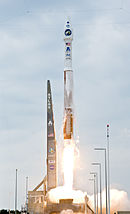Common Core Booster
| Producent | |
|---|---|
| Człon rakiet | |
| Materiały napędowe | |
| Rok pierwszego startu | 2002 |
| Osiągi | |
| Siła ciągu przy starcie | 4152 kN |
| Impuls właściwy w próżni | 253 s |
| Wymiary | |
| Długość | 32,6 m |
| Średnica | 3,81 m |
| Masa maksymalna | 306914 kg |
| Silniki | |
| Silnik 1. | |
Common Core Booster (CCB): modułowy stopień główny rakiet nośnych Atlas V produkowany przez United Launch Alliance, powstały w celu zastąpienia stalowych członów głównych wykorzystywanych w rakietach Atlas od 1957 roku. Jako drugi główny stopień rakiet serii Atlas wykorzystuje silnik RD-180 produkowany przez zakład NPO Energomasz w Moskwie.
Media użyte na tej stronie
Atlas 3F prior to failed launch attempt
Trailing a column of fire, the Atlas V(401) carrying NASA's Lunar Reconnaissance Orbiter, or LRO, and NASA's Lunar Crater Observation and Sensing Satellite, known as LCROSS, hurtles off Launch Complex 41 at Cape Canaveral Air Force Station in Florida. LRO and LCROSS are the first missions in NASA's plan to return humans to the moon and begin establishing a lunar outpost by 2020. The LRO also includes seven instruments that will help NASA characterize the moon's surface: DIVINER, LAMP, LEND, LOLA , CRATER, Mini-RF and LROC. Launch was on-time at 21:32 UTC.
CAPE CANAVERAL, Fla. – Workers lift the Atlas V rocket scheduled to launch NASA's Solar Dynamics Observatory, or SDO, into a vertical position at Launch Complex 41 on Cape Canaveral Air Force Station in Florida. SDO is the first space weather research network mission in NASA's Living With a Star Program. The spacecraft's long-term measurements will give solar scientists in-depth information about changes in the sun's magnetic field and insight into how they affect Earth. Liftoff on the United Launch Alliance Atlas V is scheduled for Feb. 3, 2010. For information on SDO, visit http://www.nasa.gov/sdo. Photo credit: NASA/Glenn Benson





